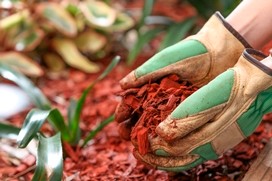Mulch and Mulching
What is Mulch?
Mulch is a layer of material, generally organic in nature but it can be inorganic, that is applied to the surface of soil as a cover. Some materials can be used “as is”, but most require mechanical processing such as grinding, chipping, or shredding. There are a number of different benefits to using mulch as a soil cover; it can:
- help conserve soil moisture by regulating soil temperature and slowing evaporation.
- suppress weed growth by blocking sunlight and regulating soil temperature, thereby preventing weed seed germination.
- improve the fertility and health of the soil through the addition of organic matter (if the mulch is organic).
- act as an erosion control technique by decreasing speed of run-on and run-off of water, being a barrier against wind, and decreasing the impact of raindrops.
- increase the aesthetics of the area by providing a “finished look.”
Common Materials Used as Mulch:
| Organic Materials | Inorganic Materials |
|---|---|
| Grass clippings | Old carpet |
| Leaves | Rubber (e.g. recycled tire rubber) |
| Hay | Landscape fabric or plastic |
| Straw | Rock and gravel |
| Shredded bark | Pulverized glass |
| Whole bark nuggets | |
| Sawdust | |
| Wood chips | |
| Shredded newspaper | |
| Compost |
Some mulch (such as straw, peat, sawdust and other wood products) can initially have a negative effect on plant growth due to the imbalance created in the carbon to nitrogen ratio by bacteria and fungi decomposing the materials (which removes nitrogen from the surrounding soil for growth).
General Information on Mulch:
The application of mulch is called mulching. Recommendations vary on how deeply mulch should be applied to a given area, but range from two (2) to four (4) inches deep.
Mulch can be applied at various times of the year to achieve varying goals.
- When applied in late winter, mulch can warm the soil by retaining heat lost during the night. Retained heat allows early seeding/transplanting of crops and can encourage faster growth.
- The application of mulch in early spring helps stabilize the soil temperature, regulate soil moisture content, and suppress weed growth.
- Late spring or early summer is often the best time to apply mulch because both soil temperature and moisture content are at optimum levels to get maximum benefit.
- Mulch can also be applied after the ground freezes in the late fall or early winter to moderate winter soil temperatures. Applying mulch before the ground has frozen may attract rodents looking for a warm place to spend the winter.
Difference Between Mulch and Compost:
- Mulch IS NOT Compost, but Compost can be Mulch

| Compost |
|---|
| Organic in nature |
| Processed to reduce pathogens |
| The process often requires a Solid Waste Permit |
| “Earthy” smell (usually) |
| Final C:N ratio should be less than 20:1 |
| Applied at 2" or less depth or can be incorporated into soil |
| Can be used as mulch |

| Mulch |
|---|
| Organic or inorganic in nature |
| Not processed to reduce pathogens |
| The process does not require a Solid Waste Permit |
| “Woodsy” smell (usually) |
| No ideal C:N ratio, but usually carbon-rich if organic |
| Applied at least 2-3" deep and not incorporated into soil |
| May turn into a carbon-rich compost-like product if organic |
| Contacts |
|---|
| Robert Wadley 615-741-4907 Robert.Wadley@tn.gov |